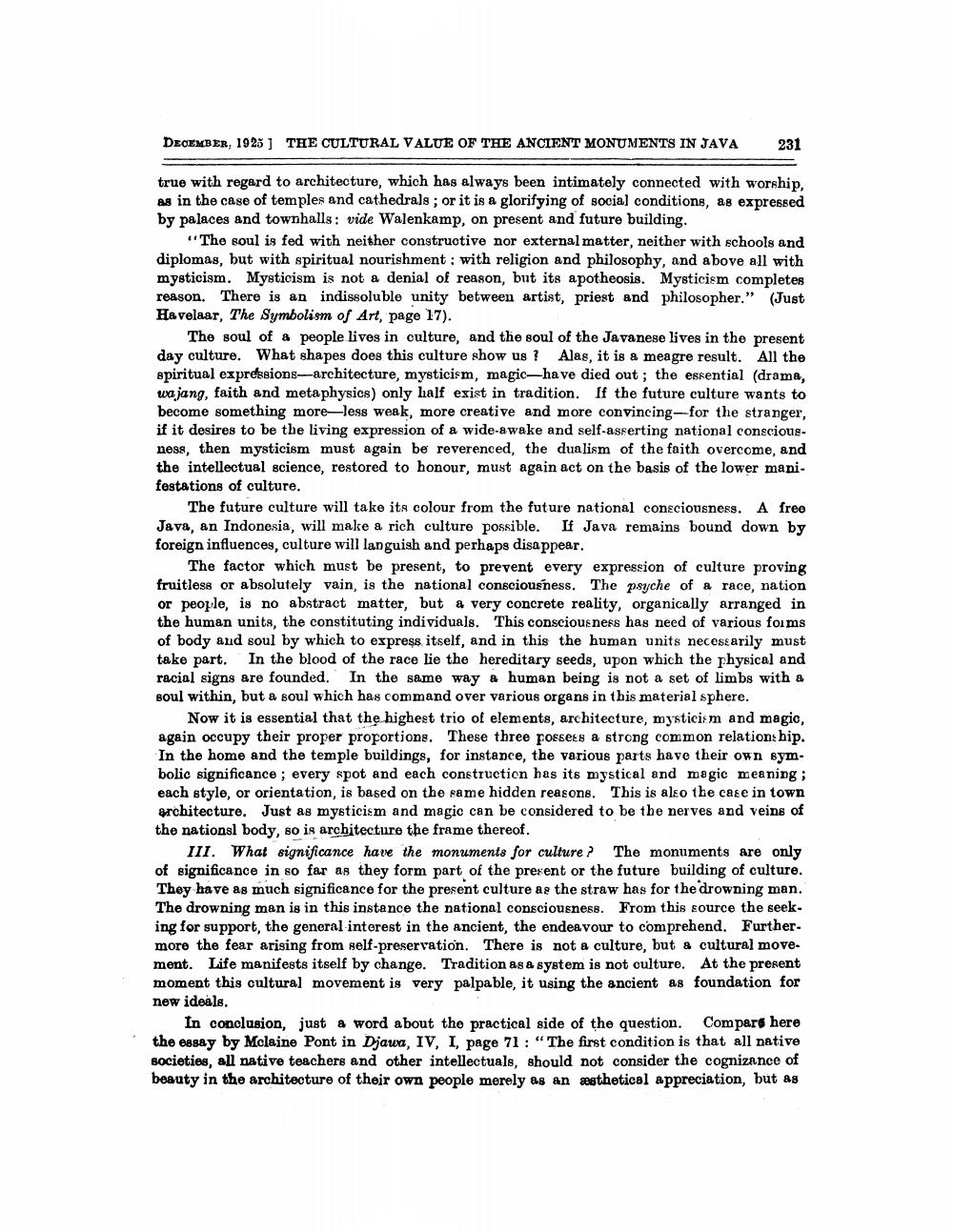________________
DECEMBER, 1925 ] THE CULTURAL VALUE OF THE ANCIENT MONUMENTS IN JAVA
231
true with regard to architecture, which has always been intimately connected with worship, as in the case of temples and cathedrals; or it is a glorifying of social conditions, as expressed by palaces and townhalls: vide Walenkamp, on present and future building.
"The soul is fed with neither constructive nor external matter, neither with schools and diplomas, but with spiritual nourishment : with religion and philosophy, and above all with mysticism. Mysticism is not a denial of reason, but its apotheosis. Mysticism completes reason. There is an indissoluble unity between artist, priest and philosopher." (Just Havelaar, The Symbolism of Art, page 17).
The soul of a people lives in culture, and the soul of the Javanese lives in the present day culture. What shapes does this culture show us ? Alas, it is a meagre result. All the spiritual expressions--architecture, mysticism, magic-have died out; the essential (drama, wajang, faith and metaphysics) only half exist in tradition. If the future culture wants to become something more-less weak, more creative and more convincing-for the stranger, if it desires to be the living expression of a wide-awake and self-asserting national conscious. ness, then mysticism must again be reverenced, the dualism of the faith overcome, and the intellectual science, restored to honour, must again act on the basis of the lower mani. festations of culture.
The future culture will take its colour from the future national coneciousness. A free Java, an Indonesia, will make a rich culture possible. If Java remains bound down by foreign influences, culture will languish and perhaps disappear.
The factor which must be present, to prevent every expression of culture proving fruitless or absolutely vain, is the national consciousness. The psyche of a race, nation or people, is no abstract matter, but a very concrete reality, organically arranged in the human units, the constituting individuals. This consciousness has need of various foims of body and soul by which to express itself, and in this the human units necessarily must take part. In the blood of the race lie the hereditary seeds, upon which the physical and racial signs are founded. In the same way a human being is not a set of limbs with a soul within, but a soul which has command over various organs in this material sphere.
Now it is essential that the highest trio of elements, architecture, mysticism and magic, again occupy their proper proportions. These three possess a strong common relationship. In the home and the temple buildings, for instance, the various parts have their own sym. bolic significance ; every spot and each construction has its mystical and magic meaning; each style, or orientation, is based on the same hidden reasons. This is also the case in town architecture. Just as mysticism and magic can be considered to be the nerves and veins of the national body, so is architecture the frame thereof.
III. What significance have the monuments for culture? The monuments are only of significance in so far as they form part of the present or the future building of culture. They have as much significance for the present culture as the straw has for the drowning man. The drowning man is in this instance the national consciousness. From this source the seeking for support, the general interest in the ancient, the endeavour to comprehend. Further. more the fear arising from self-preservation. There is not a culture, but & cultural movement. Life manifests itself by change. Tradition as a system is not culture. At the present moment this cultural movement is very palpable, it using the ancient as foundation for new ideals.
In conclusion, just a word about the practical side of the question. Compare here the essay by Molaine Pont in Djawa, IV, I, page 71 : "The first condition is that all native societies, all native teachers and other intellectuals, should not consider the cognizance of beauty in the architecture of their own people merely as an esthetical appreciation, but as




